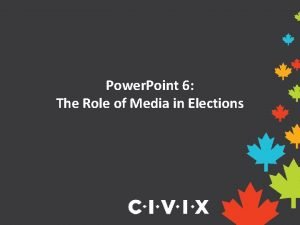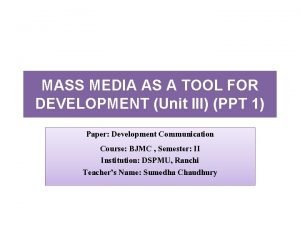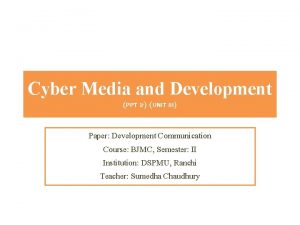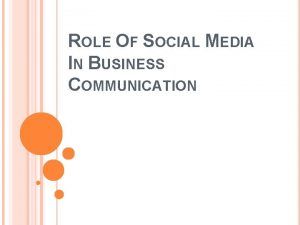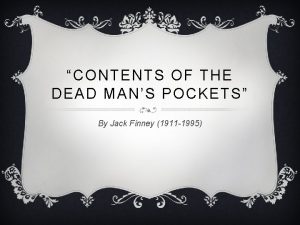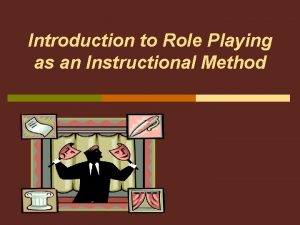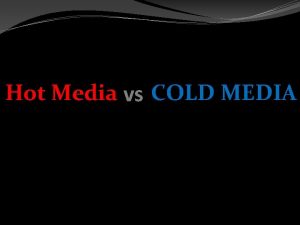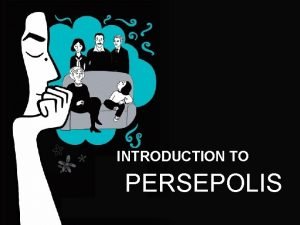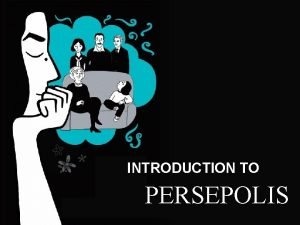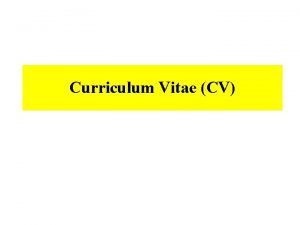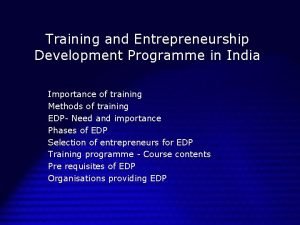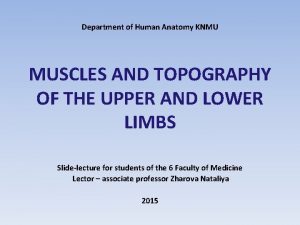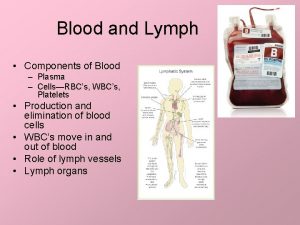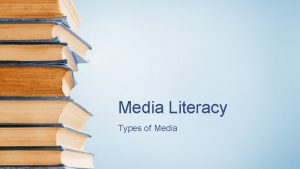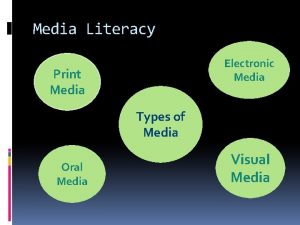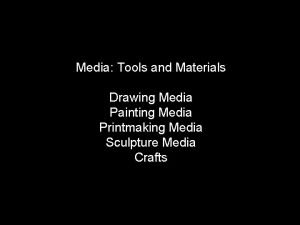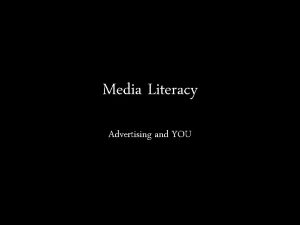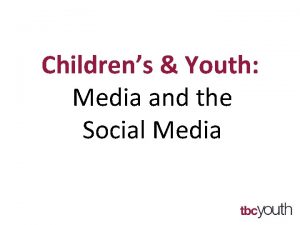Role of media Introduction Contents 1 Types and






























































































- Slides: 94

Role of media Introduction

Contents 1. Types and Characteristics of Media 2. Role of Media in globalization of Sports 3. Mobilization through Media

Radio TELEVISION Media Int rnet

Media v. Print Media: 1)Newspaper 2)Magazine v. Audio Media: 1)Radio v. Audio-Video Media: 1)Television 2)Internet

Media • Communication channels (networks) through which news, entertainment, education, data, or promotional messages are disseminated. • Media includes every broadcasting and narrowcasting (A broadcast pleases the majority, but a narrowcast attracts a small number) medium such as newspapers, magazines, TV, radio, billboards, direct mail, telephone, fax, and internet. • Media is the plural of medium.

Definition of Media Etymology of the term Media: The word media comes from the Latin word “middle. ” Media carry messages to or from a targeted audience and can add meaning to these messages. Definition: Media are the means and instruments used to convey advertising messages to the public” “

News • An account/story/report of an event, or a fact or an opinion that interests people. • A presentation of current events

Basic News Reporting • Most news stories are written in a very concise way in order to pack as much information into every line on the page. • The simplest and most common structure of this kind of writing is called the Inverted/reversed Pyramid. Inverted Pyramid: The broad base represents the most newsworthy information in the news story, and the narrow tip represents the least newsworthy information in the news story.

Media Terminologies Media: The various categories of delivery systems, including broadcast and print media. Media Planning: A series of decisions involving the delivery of messages to audiences. Media Objectives: Goals to be attained by the media strategy and program. Media Strategy: Decisions on how the media objectives can be attained. Broadcast Media: Either radio or television network or local station broadcasts.

Media Terminologies Print Media: Publications such as newspapers, magazines, direct mail etc. Media Vehicle: The specific message carrier, such as the Dawn news, PTV Sports. Coverage: The potential audience that might receive the message through the vehicle. Reach: The actual number of individual audience members reached at least once by the vehicle. Frequency: The number of times the receiver is exposed to vehicle in a specific time period.

The Media’s Functions – Entertainment – Reporting the news – Identifying public problems » Setting the public agenda » The investigative function – Socializing new generations – Providing a political forum – Making profits – Information for Sports etc

Characteristics of Media Using the most advanced technology –Internet –Satellite transmission of real-time events –Helicopters used to track sorting out events Operating in a free

Characteristics of Media Privately owned –Ownership centralized in a few giant corporations –Reporters highly energetic, motivated, and responsive to signs of news worthy stories –Operationally energetic

Types of Media Print Media Newspaper Magazine Broadcast Media Radio Television Outdoor Media Billboards Poster Interactive Media Internet Telephone

Types of Media Print media – Newspaper – Magazines – Others Broadcasting media – Radio – Television Internet – Online version of press – Information source – Venue of personal expression

Print Media Print media include: • Newspapers • Magazines • Directories • Mail brochures • Mail • Packaging • All other forms, which are produced by printing and are relatively permanent

Newspapers Characteristics Advantages Disadvantages • High coverage • Short life • Low cost • Low attentiongetting capabilities • Short lead time (the time between the initiation and completion of a production • Poor reproduction process) for placing ads quality • Ads can placed in interest • Selective reader sections exposure • Timely (current ads) • Reader controls exposure • Can be used for coupons

Magazines Characteristics Advantages • Segmentation potential • Quality reproduction • High information content • Longevity • Multiple readers Disadvantages • Long lead time for ad placement • Visual only • Lack of flexibility

Directories ØA directory is both a reference and an advertising medium. ØThe most widely known is the Yellow Pages. ØYellow Pages advertising is often the primary or only form of advertising used by many small, local retailer/seller/trader. ØA weakness of the Yellow Pages is that they are printed only once a year.

Broadcast Media • Broadcast media include radio and television. • Broadcast media differs from print in that people often do other things while listening or viewing, so messages are fleeting/short lived/brief • Broadcast commercials are more intrusive/unwelcome/unwanted than print ads.

Radio Characteristics Advantages • • • Local coverage Low cost High frequency Flexible Low production costs • Well-segmented audiences Disadvantages • Audio only • Low attention getting • Fleeting/short lived/brief message

Television Characteristics Advantages • • Mass coverage High reach Impact of sight, sound, and motion High prestige/status Low cost per exposure/contact Attention getting Favorable image Disadvantages • Low selectivity • Short message life • High production costs

Outdoor Media Advantages • Location specific • High resolution • Easily noticed Disadvantages • Short exposure time requires short ad • Poor image • Local restrictions

INTERACTIVE • A variety of media that allows the consumer to interact with the source of the message, actively receiving information and altering images, responding to questions, and so on.

Interactive media • AUDIOTEX – AUTOMATED TELEPHONE INFORMATION SERVICES • CD-ROM (Compact Disc Read-Only Memory) • FAX ON DEMAND • INTERACTIVE TV (Interactive TV (ITV or i. TV) is an approach to television advertising and programming that creates the opportunity for viewers to communicate with advertisers and programming executives by responding to a call to action) • INTERNET • KIOSKS/Booth/Stall/Counter – AVAILABLE IN HOTELS, SHOPPING MALLS • ONLINE SERVICES – An online service, also known under the title of Software as a Service (Saa. S), is a service provided by a software application running online and making its facilities available to users over the Internet via an interface (be that HTML presented by a web-browser such as Firefox, via a web-API or by any other means) – SCREEN TELEPHONY – TELEPHONES EQUIPPED WITH KEYBOARD TO ENTER AND ACCESS DATA

Internet / Interactive Media Characteristics Advantages Disadvantages • User selects product information • User attention and involvement • Interactive relationship • Direct selling potential • Flexible message platform • Limited creative capabilities • Web snarl (crowded access) • Technology limitations • Few valid measurement techniques • Limited reach

Direct Mail Characteristics Advantages • High selectivity • Reader controls exposure • High information content • Opportunities for repeat exposures Disadvantages • Poor image (junk mail)

Differences of Media Broadcast Media – Essentially a headline service – fewer topics – little depth of coverage – more audience/viewers – Source of info for every age group Print Media – Not a source for the majority – Audience are nation’s elites – Leading papers set the reporting agenda – In-depth coverage and better analysis

Comparison of Print and Broadcast Media Print Media • • News & information Summaries of past events Concrete information Success based on preserving credibility • Highlights behind-thescenes stories • Provides more critical coverage Broadcast Media • • Entertainment Play-by-play coverage Real-time action Success based on generating hype • Highlights action and heroic displays • Provides more supportive coverage

Developing The Media Plan Situation Analysis Marketing Strategy Plan Creative Strategy Plan Setting Media Objectives Determining Media Strategy Selecting Broad Media Classes Selecting Media Within Class Media Use Decision — Broadcast Media Use Decision — Print Media Use Decision — Other Media

Media Planning Difficulties • Lack of information • Inconsistent terms & Condition • Serious time pressure • Measurement problems

Media Planning Criteria Considerations • • The media mix Target market coverage Geographic coverage Scheduling Reach versus frequency Creative aspects and mood Flexibility Budget considerations

Role of Media in Globalizations of Sports

Media, Sport and the Globalization of Culture

3 5 Why Have Sports Become So Popular in Society Today? • • • The quest for excitement. Class ideology and spectator interest. Widespread organized, competitive youth sports. • Widespread media coverage.

Some important unifying observations • The mass media turns everything into mass entertainment (movies, Internet, pop music, tabloid newspapers, paperbacks, video games, computer games, and of course sports) • The production, distribution and consumption of mass entertainment is now central to all over the globe. • Sport becomes a product only as much as it can deliver a BRAND.

Sport marketers must understand: • Professional Sport has been turned into entertainment. – Rate of return becomes the ONLY argument for its existence. – Rate of return determines its nature. – Sport marketers compete against movie marketers, casinos, video games, etc. ) • Professional sports (including brands, celebrities) are now part of the experience economy and need to be marketed as such. • As a media-driven product, sport products are increasingly marketed to a global audience, eg. D. Beckham.

3 8 Economic Factors and the Globalization of Commercial Sports • Sports organisations look for global markets. – FIFA, the IRB, the NBA, etc. seek global media exposure and expansion. • Corporations use sports as vehicles for global expansion. – One goal is to make money. – Another goal is to sponsor enjoyment and pleasure to establish ideological outposts in the minds of people around the world.

3 9 Commercialisation and Changes in Sports Changes may occur in the: • structure and goals of sports • orientations of athletes, coaches and sponsors • organizations that sponsor and control sports.

4 0 The Origins of Heroic Action in Sports Commercial sports are ENTERTAINMENT üCommercial entertainment depends on attracting a mass audience. üMembers of a mass audience lack technical knowledge about a sport. üEntertaining people without technical knowledge requires heroic actions.

4 1 Commercial Sports Involve a Shift From Aesthetic to Heroic Orientations Aesthetic Orientations • Beauty and pleasure of movement • Emphasis on mastery of technical skills • Willingness to explore limits • Commitment to staying involved Heroic Orientations • Danger and excitement of movement • Emphasis on style and dramatic expression • Willingness to go beyond limits • Commitment to success of sponsor

4 2 Spectator Appeal in Sports Spectator appeal in sports depends on: • the uncertainty of an event’s outcome • the stakes associated with an event • the anticipated/expected/predicted display of excellence, heroics or dramatic displays by participants.

4 3 Sport Organisations With Commercialisation: • control shifts away from athletes; decisions are less likely to reflect their interests • control shifts toward owners, corporate sponsors, advertisers, media personnel, marketing and publicity staff, professional management staff, accountants and agents. – Athletes accept the decisions of these people, because their financial interests are at stake.

Sports and the Media: Could They Survive Without Each Other?

Characteristics of the Media • Print media: words & images on paper – Newspapers, magazines & fanzines (a magazine, usually produced by amateurs, for fans of a particular performer, ) , books, catalogues, event programs, trading cards • Electronic media: words, commentary, & images transmitted by audio and/or video devices and technologies – Radio, television, film, video games, the Internet and online publications group, or form of entertainment

The Media Provide • Information • Interpretation • Entertainment

Media Content Media content is always edited and “represented” by those who control media organizations Editing decisions are based on one or more of these goals: – Making profits – Shaping values – Providing a public service – Building artistic and technical reputations – Expressing self

Media representations of sports are carefully edited to highlight dramatic action

Media and Power The media often serve the interests of those with power and wealth in society As corporate control of media has become more concentrated, media content highlights – Consumerism – Individualism – Competition – Class inequality as natural and necessary in society

What If. . . • All TV documentaries were sponsored by environmental groups, labor organizations women’s groups? – Wouldn’t we ask questions about the content of those programs, and ask why we see what we see and why we hear what we hear? • 99% of all sports programming in the media was sponsored by capitalist corporations? – Shouldn’t we ask questions about the content of that programming, whose interests it serves, and why we see and hear what we do?

Characteristics of the Internet The Internet • Extends and radically/totally/completely changes (potentially/possibly) our connections with the world • Is not limited to sequential/serial/consecutive programming • Enables each of us to be the “editors” of our own media experiences, if we wish • Gives us the potential to create our own sport realities and experiences as spectators and virtual (computer generated/ cybernetic) athletes

Video Games & Virtual Sports Research is needed to help answer questions such as: – What are the dynamics of playing video sport games and virtual sports, and how do they differ from other sport-related experiences? – How are video sport game experiences linked with other sport experiences? – What ideological themes/subjects/topics/ideas are structured into the images and actions in video sport games? – Will virtual sports compliment/praise/tribute or replace sports as we know them today?

Fantasy Sports • How has the emergence/appearance/rise/development of fantasy/imagined/fictional football, baseball, etc. contributed to an increase in sport media consumption?

Video Games as Simulated/imitation/fake/replicated Sports ¿The graphics and images in video games now come close to matching images in televised sports ¿TV producers now use special filters to make the action in televised games look like video games ¿Some athletes use video sport games to train ¿Some children today are introduced to sports through video games ¿Being good at playing video sport games is a source of status among many young people ¿Playing sport video games provides regular social occasions for many people, especially young males


Do Sports Depend on the Media? • No, not when they are organized by and for the players themselves • Yes, when they are organized as forms of commercial entertainment – Media coverage attracts attention to sports and provides news of results – Television coverage remains a key factor in the growth and expansion of commercial sports



Have Sports Sold Out to the Media? Probably not – for two reasons: • Sports are not shaped primarily by the media in general or TV in particular – Sports are social constructions that emerge/arise/develop in connection with many social relationships • The media, including TV, do not operate in a political and economic vacuum (space) – Media are regulated by government and market factors, which influence and set limits on media coverage & content

Do the Media Depend on Sports? • Most media do not depend on sports for content or sales • Daily newspapers have depended on “sports sections” to increase circulation and advertising revenues • Many television companies have depended on sports to fill programming schedules, attract male viewers and the sponsors that want to reach them – Many sport events have media audiences with clearly identifiable “demographics” (particular section of population)

Trends in Televised Sports • Rights fees have escalated rapidly since the 1960 s • Sports programming has increased dramatically • As more events are covered, ratings for some particular events have decreased – Audience fragmentation (division/break up/destruction) has occurred • Television companies use sports events to promote other programming • Television companies are parts of conglomerates (corporations/companies/firms) that now own teams, sport events, and other businesses

Executives’ decisions in global media companies influence what sports we see and read about in the media

Alcohol & Tobacco Sponsorships • Corporations that sell alcohol and tobacco see sports as key vehicles for promoting their products in connection with activities that people define as healthy • If these corporations cannot sponsor televised events, they put signage (signs collectively, especially commercial or public display signs. ) on people, equipment, and facilities that are viewed during television coverage.

Corporate Sponsorships and Gender Ideology • Decision-making power in large media corporations rests with many male executives who love sports • The values and experiences of men are deeply embedded (fixed/rooted/set in) in the cultures of these corporations • When sports emphasize competition, domination, and achievement, many male executives feel that these are crucial factors in their companies – This means they will pay large fees to hire coaches and athletes as “motivational” speakers in their companies

Images and Messages in Media Sports (I) Media coverage is constructed around specific themes and messages: • Success themes – Emphasis on winners, losers, and final scores – Emphasis on big plays, big hits, and sacrificing self for team success (continued)

Images and Messages in Media Sports (II) Media coverage is constructed around specific themes and messages: • Masculinity and femininity themes (subject/topic) – Coverage privileges (freedoms/rights/civil liberties) men over women – Heterosexuality (sexually attracted to people of the opposite sex) is assumed/expected; homosexuality is erased and ignored – Coverage reproduces dominant ideas about manhood, but may challenge ideas about femininity (continued)

Images and Messages in Media Sports (III) • Race and ethnicity (origin/culture/civilization/society) themes – Racial ideology has influenced coverage of black athletes, especially males – Whiteness is erased in coverage; it is assumed as the standard • Nationalism is emphasized – “We” - “They” distinctions are common • Individualism is highlighted • Aggression is glorified; athletes are presented as warriors

Media sports present reallife violence. Should sport programs be rated for violence? *Homicide (killing of one person by another)

Media Impact on Sport-Related Behaviors • Active participation in sports – Some negative, some positive effects • Attendance at sport events – Media generally increase attendance at elite events, but may decrease attendance at local events • Gambling on sports – Media are indirectly linked to gambling – Internet may change this to direct link

Audience Experiences With Media Sports Research shows that • Watching television sports is not a major activity in the lives of most adults • Football “widows” and men who just sit in front of the TV watching sports are not as common as many people think. – Men and women who live together often share the experience of watching sports – Most partners in couples accommodate each other’s viewing habits over time

The Profession of Sports Journalism • The work of sports journalists does matter when it comes to cultural ideology and public consciousness (awareness/perception) • Tensions between players and sportswriters has intensified as differences in their salaries and backgrounds have become more pronounced (marked/distinct/noticeable) • Ethical (Moral/right) issues have become increasingly important in sports journalism because the stakes (risks/dangers) are so high for teams, athletes, coaches, owners, etc.

“If it bleeds, it leads” in the local news and in sports.


Comparison of Sportswriters and Announcers • • • Sportswriters Work behind scenes Seldom recognized Low salaries; paid by publications Low regulation by sport management Job focuses on providing information • • • Announcers Celebrity status Public recognition High salaries; often paid by management Comments regulated by management Job focuses on “selling” the sport

Comparison of Print and Broadcast Media Print Media • • News & information Summaries of past events Concrete information Success based on preserving credibility • Highlights behind-the-scenes stories • Provides more critical coverage • • • Broadcast Media Entertainment Play-by-play coverage Real-time action Success based on generating hype Highlights action and heroic displays Provides more supportive coverage

Summary • Global Sport as Media Spectacle/scene/vision/show • Changing economics • Fragmentation/division of sport audiences • Appearance of Monopolizers • Awesome vehicle for corporate interests: – Targeting: Localization and globalization – New audiences – Programming

Mobilization Through Media

Media representations of sports are carefully edited to highlight desirable images, identities, and ideologies of a city, region, or nation. What story is being narrated here?

Community What comes first in your mind when you think or hear the word “COMMUNITY” ?

What is a Community A Community is a set of people living together with common interest” We all live in a community. There are different things that bind us together. It includes; q Beliefs q Values q Language q Religion q Culture q Occupation

Role of Community Mobilizers A mobilizer is a person who mobilizes, i. e. gets things moving. Social animator (An animator is an artist who creates multiple images, • • • known as frames, which give an illusion of movement called animation when displayed in rapid sequence. Animators can work in a variety of fields including film, television, and video games). A Catalyst Bringing People Together Building Trust Encouraging Participation Facilitating Discussion and Decision-making Helping Things to Run Smoothly. Facilitation in community mobilization process

Community Meetings Gathering People at ONE Platform Puppet Show & Theatre Village Literacy Fair Sports & Games Electronic & Print Media Pamphlets & Handouts

In INDIA Ø 78. 8 Million number of newspaper are sold Daily. Ø 41, 66, 438 number of magazines are sold on weekly & monthly basis. Ø 665 Television Channels are there. Ø 65 Million active internet users are there.

This is everyday Media is integral part of Modern Society. .

Role…. What should be ? ? ? üInformative üPositive üCreative üMotivating üEntertaining

Yes, Many media are like this, But some…………… ØAre Negative Oriented (focused on/in favour of) ØGive “Masala” News ØBoring ØDiscouraging ØCrime Encouraging

Ideal Media üShould be Free from Pressure üFact Finding üNation Building

Media Intrusiveness Media vary in their degree of intrusiveness/inappropriateness/insensitivity/coming without invitation Ways to reduce intrusiveness include: § Choose media in which the target audience is interested in the product. § Ask customers what type of information they would like to receive, in what way, and when.


What we should do? ? ? üWe should encourage the good media. üWe should give our constructive criticism to them for improvement. üWe should participate in them by Writing, Presentations & Video programs. üWe should make all others aware about the nation building Media.


MEDIA – We need it § It will be here, irrespective of our choice. § So let us try to Have a media, which is § Positive in Approach § Provide Real Information § & § Help In Nation Building


Any Question
 Web role in azure
Web role in azure Contents introduction
Contents introduction Rollenmodell
Rollenmodell Statuses and their related roles determine
Statuses and their related roles determine Highly exposed to and actively using media.
Highly exposed to and actively using media. Two aims of allocation of industrial estate
Two aims of allocation of industrial estate Industrial estate definition
Industrial estate definition Role of news media
Role of news media Mass media as a tool for development
Mass media as a tool for development What is the role of cyber media in development
What is the role of cyber media in development Gross rating points
Gross rating points Importance of social media in business communication
Importance of social media in business communication Objectives of communication ppt
Objectives of communication ppt Content of a dead man's pocket
Content of a dead man's pocket Visceral pericardium
Visceral pericardium Outlining and organizing the speech contents
Outlining and organizing the speech contents Contents of the dead man's pocket questions and answers
Contents of the dead man's pocket questions and answers Introduction to role play
Introduction to role play Introduction of role play
Introduction of role play Hot and cold media examples
Hot and cold media examples Hot media and cold media
Hot media and cold media Wired data transfer
Wired data transfer Luhan hot
Luhan hot Venn diagram media and information literacy
Venn diagram media and information literacy Poster about importance of media and information literacy
Poster about importance of media and information literacy Introduction for portfolio
Introduction for portfolio Deep perineal pouch contents
Deep perineal pouch contents Fresh frozen plasma contents
Fresh frozen plasma contents Ffp clotting factors
Ffp clotting factors Mediastinum
Mediastinum Ligamentum patellae
Ligamentum patellae Superior mediastinum contents
Superior mediastinum contents The immortal life of henrietta lacks table of contents
The immortal life of henrietta lacks table of contents Contents of internal capsule
Contents of internal capsule Posterior scapular region
Posterior scapular region Golden lampstand tabernacle
Golden lampstand tabernacle So we meet again my dear doctor
So we meet again my dear doctor Widest part of small intestine
Widest part of small intestine Mla table of contents
Mla table of contents Contents of stylistic lexis
Contents of stylistic lexis Front
Front Continuous variable example
Continuous variable example Example of appendix in report
Example of appendix in report Platelets transfusion indication
Platelets transfusion indication Occupied
Occupied Mediastinum and pericardium
Mediastinum and pericardium Indicative abstract example
Indicative abstract example Persepolis table of contents with page numbers
Persepolis table of contents with page numbers Persepolis table of contents
Persepolis table of contents Interactive notebook table of contents
Interactive notebook table of contents Cryoprecipitate contains
Cryoprecipitate contains Cerebral peduncle
Cerebral peduncle Dartos fascia
Dartos fascia Greater sciatic foramen contents
Greater sciatic foramen contents 5 w's of event management
5 w's of event management Contents of the middle mediastinum
Contents of the middle mediastinum Posterior mediastinum contents
Posterior mediastinum contents Carotid triangle contents
Carotid triangle contents Triangular space contents
Triangular space contents Contents of curriculum vitae
Contents of curriculum vitae Ctd module 5 table of contents
Ctd module 5 table of contents Preparation of cost audit report
Preparation of cost audit report Interactive notebook table of contents
Interactive notebook table of contents The city of ember summary
The city of ember summary Fresh frozen plasma transfusion time
Fresh frozen plasma transfusion time Air pollution contents
Air pollution contents Magazine contents page analysis
Magazine contents page analysis Cubital fossa boundaries
Cubital fossa boundaries Fossa in elbow joint
Fossa in elbow joint Anterior border of sternocleidomastoid
Anterior border of sternocleidomastoid Muscle compartment of thigh
Muscle compartment of thigh Medial aspect of antecubital fossa
Medial aspect of antecubital fossa Femoral triangle
Femoral triangle Transverse humeral ligament
Transverse humeral ligament Historical background of hamlet
Historical background of hamlet Mnemonic operation code
Mnemonic operation code Ctd module 5 table of contents
Ctd module 5 table of contents Urogenital triangle contents
Urogenital triangle contents Entrepreneurship training and development
Entrepreneurship training and development Table of contents scrapbook
Table of contents scrapbook Ansa cervicalis
Ansa cervicalis Table of contents science
Table of contents science Styloid apparatus
Styloid apparatus Logbook examples for science project
Logbook examples for science project Absolute bioavailability
Absolute bioavailability Clipart table of contents
Clipart table of contents Contents of superficial perineal pouch
Contents of superficial perineal pouch Incisive foramen contents
Incisive foramen contents Trial master file contents
Trial master file contents Define health education
Define health education Ctd triangle
Ctd triangle Determination of contents of cold drinks
Determination of contents of cold drinks Indicate nerve passing through cruropopliteal canal:
Indicate nerve passing through cruropopliteal canal: Contents of a dead man's pocket conflict
Contents of a dead man's pocket conflict Plasma components
Plasma components







